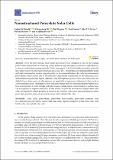Files in this item
Nanostructured perovskite solar cells
Item metadata
| dc.contributor.author | McDonald, Calum | |
| dc.contributor.author | Ni, Chengsheng | |
| dc.contributor.author | Maguire, Paul | |
| dc.contributor.author | Connor, Paul | |
| dc.contributor.author | Irvine, John T.S. | |
| dc.contributor.author | Mariotti, Davide | |
| dc.contributor.author | Svrcek, Vladimir | |
| dc.date.accessioned | 2019-10-18T10:30:07Z | |
| dc.date.available | 2019-10-18T10:30:07Z | |
| dc.date.issued | 2019-10-18 | |
| dc.identifier | 265420840 | |
| dc.identifier | 85d4eb8f-1b1b-4e37-9676-14c3cc7fc264 | |
| dc.identifier | 85054594993 | |
| dc.identifier | 85074229995 | |
| dc.identifier | 000495666800136 | |
| dc.identifier.citation | McDonald , C , Ni , C , Maguire , P , Connor , P , Irvine , J T S , Mariotti , D & Svrcek , V 2019 , ' Nanostructured perovskite solar cells ' , Nanomaterials , vol. 9 , no. 10 , 1481 . https://doi.org/10.3390/nano9101481 | en |
| dc.identifier.issn | 2079-4991 | |
| dc.identifier.other | ORCID: /0000-0002-1492-7590/work/63380886 | |
| dc.identifier.uri | https://hdl.handle.net/10023/18703 | |
| dc.description | Funding: UK EPSRC EP/K022237/1, EP/M024938/1 and EP/R023638/1. | en |
| dc.description.abstract | Over the past decade, lead halide perovskites have emerged as one of the leading photovoltaic materials due to their long carrier lifetimes, high absorption coefficients, high tolerance to defects, and facile processing methods. With a bandgap of ~1.6 eV, lead halide perovskite solar cells have achieved power conversion efficiencies in excess of 25%. Despite this, poor material stability along with lead contamination remains a significant barrier to commercialization. Recently, low-dimensional perovskites, where at least one of the structural dimensions is measured on the nanoscale, have demonstrated significantly higher stabilities, and although their power conversion efficiencies are slightly lower, these materials also open up the possibility of quantum-confinement effects such as carrier multiplication. Furthermore, both bulk perovskites and low-dimensional perovskites have been demonstrated to form hybrids with silicon nanocrystals, where numerous device architectures can be exploited to improve efficiency. In this review, we provide an overview of perovskite solar cells, and report the current progress in nanoscale perovskites, such as low- dimensional perovskites, perovskite quantum dots, and perovskite-nanocrystal hybrid solar cells. | |
| dc.format.extent | 28 | |
| dc.format.extent | 8038584 | |
| dc.language.iso | eng | |
| dc.relation.ispartof | Nanomaterials | en |
| dc.subject | Solar cells | en |
| dc.subject | Perovskites | en |
| dc.subject | Perovskite nanocrystals | en |
| dc.subject | Perovskite quantum dots | en |
| dc.subject | Low-dimensional perovskites | en |
| dc.subject | Nanocrystal solar cells | en |
| dc.subject | Organis-inorganic hybrid solar cells | en |
| dc.subject | Lead halide solar cells | en |
| dc.subject | Hybrid solar crystals | en |
| dc.subject | QC Physics | en |
| dc.subject | QD Chemistry | en |
| dc.subject | TK Electrical engineering. Electronics Nuclear engineering | en |
| dc.subject | Chemical Engineering(all) | en |
| dc.subject | Materials Science(all) | en |
| dc.subject | T-NDAS | en |
| dc.subject | SDG 7 - Affordable and Clean Energy | en |
| dc.subject.lcc | QC | en |
| dc.subject.lcc | QD | en |
| dc.subject.lcc | TK | en |
| dc.title | Nanostructured perovskite solar cells | en |
| dc.type | Journal item | en |
| dc.contributor.sponsor | EPSRC | en |
| dc.contributor.institution | University of St Andrews. School of Chemistry | en |
| dc.contributor.institution | University of St Andrews. St Andrews Sustainability Institute | en |
| dc.contributor.institution | University of St Andrews. EaSTCHEM | en |
| dc.contributor.institution | University of St Andrews. Centre for Designer Quantum Materials | en |
| dc.identifier.doi | https://doi.org/10.3390/nano9101481 | |
| dc.description.status | Peer reviewed | en |
| dc.identifier.url | https://www.mdpi.com/2079-4991/9/10/1481 | en |
| dc.identifier.grantnumber | EP/K022237/1 | en |
This item appears in the following Collection(s)
Items in the St Andrews Research Repository are protected by copyright, with all rights reserved, unless otherwise indicated.

